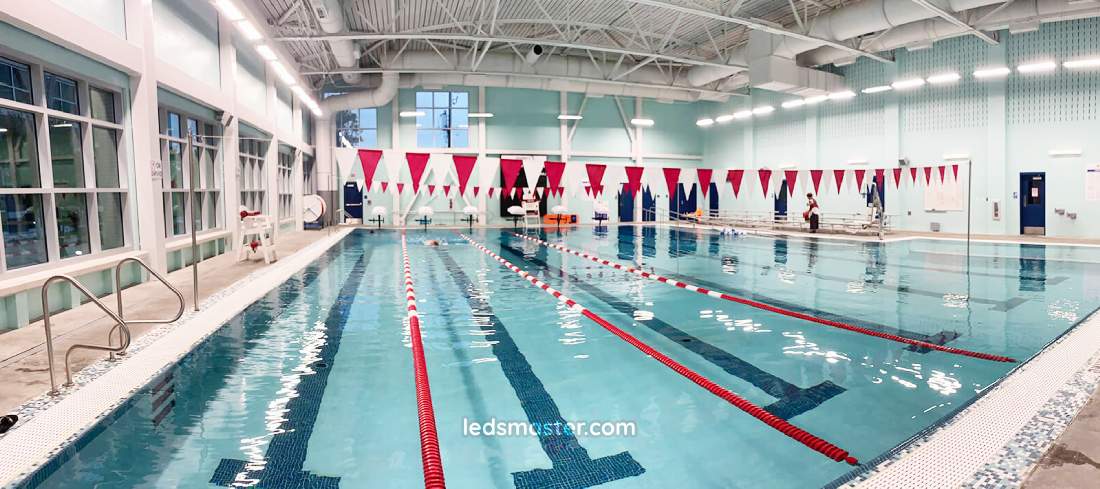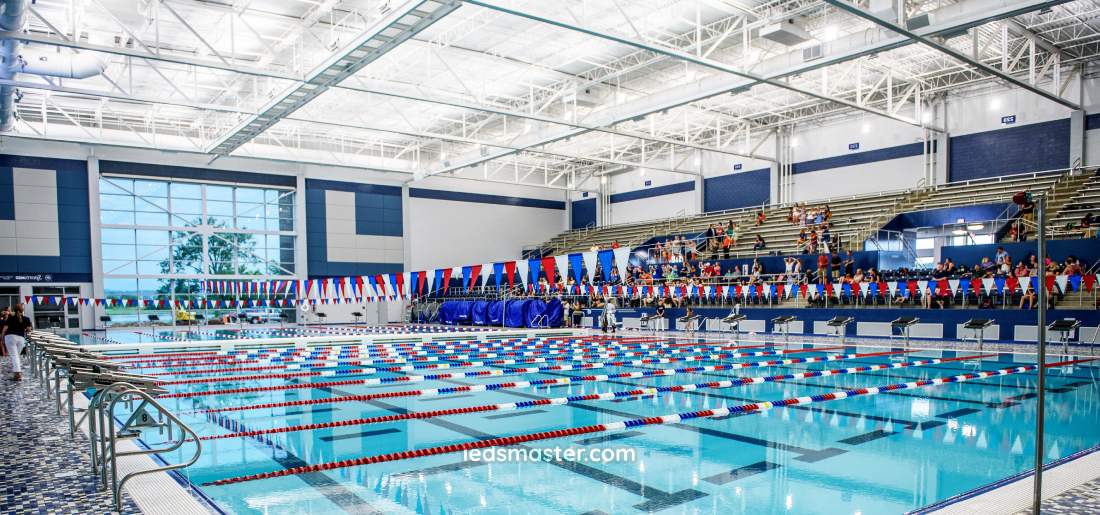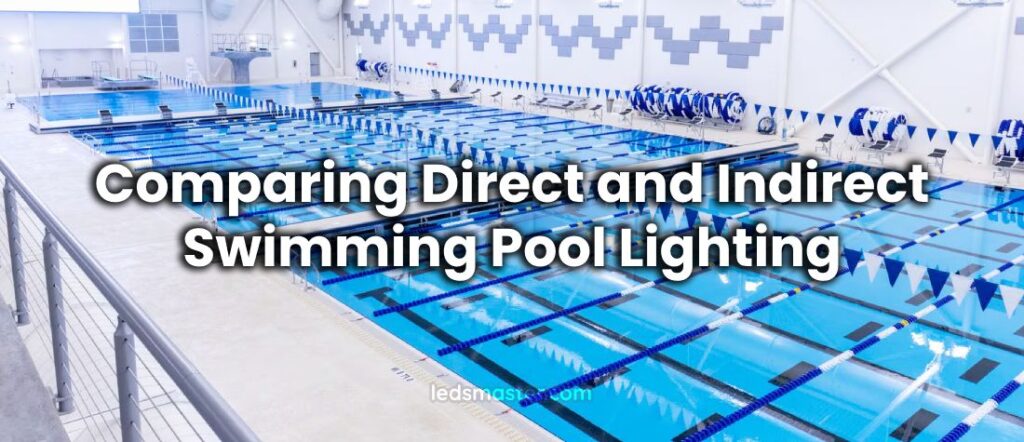Lighting up a swimming pool presents challenges due to the uneven water surface. Today, LED replacements for traditional metal halide, HPS, LPS, mercury, or fluorescent swimming pool lights are increasingly common due to the many advantages of LEDs. For example, primary and secondary reflections from traditional lighting cause glare, making swimmers, trainers, and trainees uncomfortable. By switching to LED lights, glare is reduced by 45%.
A well-designed lighting plan for swimming pools must consider overall power, beam angle design, and fixture placement. Given the higher concentration of water vapor in swimming pool environments compared to other sports venues, LED lights with a high IP rating are essential. Our LED lights, with an IP66 certification, protect the fixtures from splashing water, high humidity, and corrosion, making them ideal for swimming pools.
Let’s explore the two major options for swimming pool ceiling lighting.
Table of Contents
ToggleDirect Lighting Plan

Direct lighting fixtures are a staple in professional swimming competitions, where the need for high-power floodlights to provide ample illumination is paramount. This approach requires a large quantity of lights to ensure every corner of the pool is sufficiently lit, making it suitable for events where visibility is crucial for both athletes and spectators. While the initial cost of implementing a direct lighting system can be significant, it is a necessary investment to meet the stringent lighting requirements of competitive swimming.
In a standard swimming pool, achieving high-level illumination involves more than just brightness; it also requires meticulous control of glare for both the surface and underwater areas. Glare can be particularly problematic in swimming pools due to the reflective nature of water, which can cause discomfort and visibility issues. To mitigate this, precise positioning of the lights is essential. The angle of incidence should ideally be around 50 degrees, which helps to avoid glare caused by direct reflection off the water’s surface.
LED lights have become the preferred choice for replacing traditional metal halide or halogen lamps in direct swimming pool lighting. This preference is driven by several key advantages: LEDs have a much longer lifespan—up to 40 years—and offer significantly higher lighting efficiency, which can be improved by as much as 50% compared to older technologies. This increased efficiency means that fewer lights are needed to achieve the same level of illumination, reducing both energy consumption and maintenance costs over time.
Benefits of Direct Lighting
Thorough Illumination of the Pool Area
Direct lighting involves strategically positioning lights to point downward toward the swimming pool. This method ensures that the entire pool area is comprehensively illuminated, leaving no shadows or dark spots. By bathing the pool in bright, consistent light, direct lighting creates an environment where every detail of the water’s surface and the surrounding areas is clearly visible. This thorough illumination is not just about enhancing visibility; it also plays a crucial role in the safety and efficiency of swimming activities.
Enhanced Visibility for Swimmers, Coaches, and Spectators
One of the primary advantages of direct lighting is the significant enhancement of visibility for everyone involved in swimming activities. Swimmers can see the pool’s layout and their surroundings clearly, which is vital for both performance and safety. For coaches, direct lighting ensures that they can closely monitor their athletes’ techniques, providing immediate and accurate feedback. Spectators, too, benefit from this enhanced visibility, as they can follow the action in the pool without missing any critical moments. This clear visibility is especially important during competitions, where every detail can influence the outcome.
Essential for Competitive Environments
In competitive swimming, the importance of clear and consistent lighting cannot be overstated. Direct lighting provides the brightness and uniformity needed for accurate timekeeping and fair judging. Precise visibility ensures that all competitors are equally visible, allowing officials to make accurate and fair decisions. This level of lighting also helps in minimizing any visual distractions that could affect a swimmer’s performance. By maintaining a well-lit environment, direct lighting upholds the integrity of the competition, ensuring that results are based solely on athletic performance.
Enhanced Viewing Experience for Audiences
For audiences, direct lighting significantly enhances the overall viewing experience. Whether they are watching from the stands or through live broadcasts, spectators can enjoy a clear and uninterrupted view of the swimming events. The bright and consistent lighting makes it easier to follow the swimmers’ movements, appreciate their techniques, and stay engaged with the competition. This improved visibility also adds to the aesthetic appeal of the event, making the swimming pool look more vibrant and professional.
Indirect Lighting Plan

Contrary to the direct lighting plan, the “indirect” approach is well-suited for recreational pools. This method involves directing the lights toward the ceiling, using the reflected light to illuminate the swimming pool. While indirect lighting may reduce efficiency slightly due to partial absorption by the ceiling, it offers a significant advantage in glare reduction. By utilizing only secondary reflection, the glare is minimized, creating a more comfortable environment for swimmers.
In an indirect lighting setup, LED swimming pool flood lamps are typically mounted on the walls rather than the ceiling. This placement simplifies maintenance, as there is no need to climb to the ceiling for replacements or adjustments. The ease of access is particularly beneficial in recreational settings, where maintenance staff may need to frequently service the lighting fixtures to ensure optimal performance and safety.
Benefits of Indirect Lighting
Reduction in Glare
One of the primary benefits of indirect lighting is its ability to significantly reduce glare. Unlike direct lighting, where light sources shine directly onto the pool’s surface, indirect lighting involves reflecting light off the ceiling or walls before it reaches the pool. This reflection process softens the light’s intensity, which helps to eliminate harsh reflections on the water’s surface. The result is a visually pleasing environment where the absence of glare makes it more comfortable for swimmers to navigate the pool. By minimizing glare, indirect lighting enhances the overall swimming experience, making it safer and more enjoyable for users.
Enhanced Visual Comfort
Indirect lighting creates a more comfortable visual environment by diffusing the light more evenly throughout the pool area. This diffusion reduces the risk of eye strain and discomfort, allowing swimmers to maintain better visibility and orientation in the water. Coaches and lifeguards also benefit from this reduced glare, as it allows them to monitor swimmers more effectively without the distraction of harsh reflections. For spectators, indirect lighting provides a more pleasant viewing experience, enabling them to watch the events with greater ease and comfort.
Uniform Distribution of Light
Another significant advantage of indirect lighting is its contribution to a more uniform distribution of light. This method ensures that light is spread evenly across the entire pool area, reducing the occurrence of shadows and dark spots. Uniform illumination is particularly important in recreational pools, where a relaxing and inviting atmosphere is desired. Swimmers can enjoy a well-lit environment that feels open and spacious, enhancing their overall experience. The consistent lighting also aids in creating a safer environment, as potential hazards are more visible.
Aesthetic Appeal and Atmosphere
Indirect lighting greatly enhances the aesthetic appeal of the pool area. The softer, diffused light creates a serene and inviting atmosphere, making the space more attractive to users. This type of lighting can transform a pool area into a visually stunning environment that encourages relaxation and leisure. For facilities aiming to provide a high-end experience, indirect lighting is an excellent choice to achieve a sophisticated and welcoming ambiance. It enhances the architectural features of the pool area, highlighting textures and colors in a way that direct lighting cannot.
Ideal for Various Pool Settings
Indirect lighting is versatile and can be effectively used in various pool settings, including recreational, therapeutic, and leisure pools. In recreational pools, the soft and uniform light enhances the overall user experience by creating a calm and enjoyable environment. For therapeutic pools, the gentle lighting can help to create a soothing atmosphere conducive to relaxation and healing. Leisure pools benefit from the inviting ambiance created by indirect lighting, making them more appealing to visitors looking for a pleasant and enjoyable swimming experience.
Conclusion
Both direct and indirect lighting plans offer unique benefits for swimming pools. Direct lighting is crucial for professional competitions, providing high-level illumination and precise glare control for clear visibility. Using LED lights enhances efficiency and longevity, making it cost-effective for competitive pools.
Conversely, indirect lighting suits recreational pools, offering a comfortable and aesthetically pleasing atmosphere. It significantly reduces glare and ensures uniform light distribution, creating an inviting environment. LED lights in indirect setups also enhance energy efficiency and ease of maintenance, making them ideal for leisure pools.

